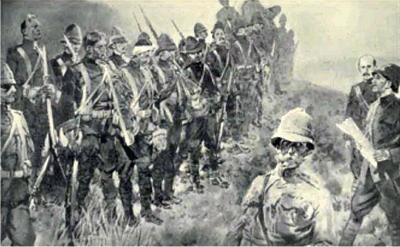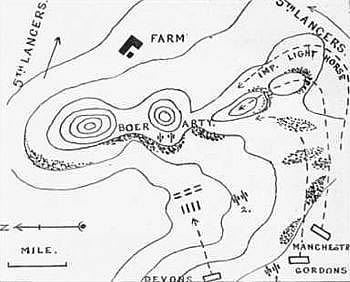3,50018 guns 1,0003 guns Result British victory | Date 21 October 1899 | |
 | ||
55 dead205 wounded 46 dead105 wounded181 MIA or captured Similar Second Boer War, Siege of Ladysmith, Battle of Talana Hill, Battle of Colenso, Battle of Spion Kop | ||
Battle of elandslaagte
The Battle of Elandslaagte was a battle of the Second Boer War, and one of the few clear-cut tactical victories won by the British during the conflict. However, the British force retreated afterwards, throwing away their advantage.
Contents
Prelude

When the Boers invaded Natal, a force under General Kock (consisting mainly of men of the Johannesburg Commando, with detachments of German, French, Dutch, American, and Irish volunteers) occupied the railway station at Elandslaagte on 19 October 1899, thus cutting the communications between the main British force at Ladysmith and a detachment at Dundee. Learning that the telegraph had been cut, Lieutenant General Sir George White sent his cavalry commander, Major General John French to recapture the station.

Arriving shortly after dawn on 21 October, French found the Boers present in strength, with two field guns. He telegraphed to Ladysmith for reinforcements, which shortly afterwards arrived by train.
The battle
While three batteries of British field guns bombarded the Boer position, and the 1st Battalion, the Devonshire Regiment advanced frontally in open order, the main attack commanded by Colonel Ian Hamilton (1st Battalion, the Manchester Regiment, 2nd Battalion, the Gordon Highlanders and the dismounted Imperial Light Horse) moved around the Boers' left flank. The sky had steadily been growing dark with thunderclouds, and as the British made their assault, the storm burst. In the poor visibility and pouring rain, the British infantry had to face a barbed wire farm fence, in which several men were entangled and shot. Nevertheless, they cut the wire or broke it down, and occupied the main part of the Boer position.

Some small parties of Boers were already showing white flags when General Kock led a counterattack, dressed in his top hat and Sunday best. He drove back the British infantry in confusion, but they rallied, inspired by Hamilton (and reportedly, a bugler of the Manchesters and a Pipe Major of the Gordons) and charged again. Kock and his companions were killed.
As the remaining Boers mounted their ponies and tried to retreat, two squadrons of British cavalry (from the 5th Lancers and the 5th Dragoon Guards) got among them with lances and sabres, cutting down many. This was one of the few occasions during the Boer war in which a British cavalry charge made contact.
The two Boer field guns fell into British hands. They were found to have originally been British and had been captured by the Boers in the aftermath of the Jameson Raid.
Aftermath
The way was now clear for the British detachment at Dundee to fall back on the main British force, but Sir George White feared that 10,000 Boers from the Orange Free State were about to attack Ladysmith, and ordered the force at Elandslaagte to fall back there. The British were tired and many officers had been killed, and the retreat became a disorderly scramble. The detachment at Dundee was once again isolated, and was forced to make an exhausting detour before they could reach safety. The Boer forces re-occupied Elandslaagte two days later.
